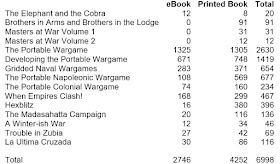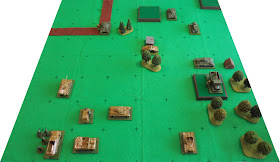The
1st Panzer Division comprised:
- General Hentzau (Above average; 6 SPs)
- 4th Divisional HQ (Average; 2 SPs)
- 1st Armoured Car Battalion (Average; 2 SPs)
- 1st Panzer Regiment (Average; 3 SPs)
- 2nd Panzer Regiment (Average; 3 SPs)
- 7th Motorised Infantry Regiment (Average; 4 SPs + 3 SPs)
- 4th Artillery Regiment (Average; 2 SPs)
- 4th Panzerjager Battalion (Average; 2 SPs)
- Total strength: 27 SPs
- Exhaustion Point: 9 SPs
The
1st Tank Corps comprised:
- DivCom Borodin (Below average; 6 SPs)
- 1st Armoured Car Regiment (Average; 2 SPs)
- 1st Tank Brigade (Average; 3 SPs)
- 2nd Tank Brigade (Average; 3 SPs)
- 3rd Tank Brigade (Average; 3 SPs)
- 10th Motor Rifle Regiment (Average; 4 SPs + 2 SPs)
- Total strength: 23 SPs
- Exhaustion Point: 8 SPs
Because the German invasion was unexpected, the
1st Tank Corps had not yet been able to concentrate, and was still scattered over a number of locations. These were determined randomly using a system similar to that used to create the terrain map.
(A D6 die was thrown in turn for each unit to determine which row of grid squares in the left-hand column the location count would start in. 2D6 dice were then thrown, and the combined scores determined how many grid squares across, down, and back from the starting grid square was the one in which the unit was located at the start of the battle.)
The Russian units were located as shown on the following map:
A map of the battlefield showing the locations of the Russian defenders.
A photograph of the battlefield showing the locations of the Russian defenders.
The abilities of the respective commanders affected the median values of playing cards used to determine how many units the red (Russian) and black (German) commanders could activate each turn, as did the quality of their respective communications. Thus,
DivCom Borodin – who was rated as below average (-1) and who had poor communications links (-1) – had a much lower median playing card value (2) than
General Hentzau, who was rated as above average (+1) and who had good communication links (+1), which gave the German a median playing card value of 6.
Turn 1
The Germans moved first. They turned over a 6 of Clubs, and could activate up to six units.
Led by the
1st Armoured Car Battalion, the bulk of the
1st Panzer Division advanced onto the battlefield in an arrowhead formation, with the
1st Panzer Regiment on the left, the
4th Divisional HQ (with
General Hentzau) in the centre, and the
2nd Panzer Regiment on the right. Immediately behind was the
4th Artillery Regiment.
The
2nd Panzer Regiment immediately engaged the
2nd Tank Brigade, and destroying 1 SP.
The
1st Armoured Car Battalion also fired at the
2nd Tank Brigade, and forced them to retreat.
The Russians turned over a 2 of Diamonds, and could activate up to two units.
Realising that the German attack was likely to overwhelm his Corps before his units were able to deploy into proper defensive positions,
DivCom Borodin rushed to join the
3rd Tank Brigade. He also ordered the
1st Tank Brigade to advance to meet the oncoming Germans.
The situation at the end of Turn 1.
Turn 2
The
4th Artillery Regiment fired at the
10th Motor Rifle Regiment, and hit the unit's transport
and caused casualties to the unit.
The Russians moved first, and turned over a 2 of Hearts. Therefore, they could activate up to two units.
DivCom Borodin might not have been a very experienced or able Soviet commander, but he knew that he had to take the battle to the Germans. He ordered the
10th Motor Rifle Regiment to get off the top of the hill it was on as soon as possible, whilst he personally led the
3rd Tank Brigade forward to engage the
1st Armoured Car Battalion. This forced the
1st Armoured Car Battalion to fall back.
The Germans turned over a 5 of Clubs, and could activate up to five units.
The
1st Armoured Car Battalion charged forward, and occupied a position near to a small settlement from where they were able to fire into the flank of the
2nd Tank Brigade. Its fire caused further losses to the
2nd Tank Brigade, whose situation was becoming parlous.
The
2nd Panzer Regiment turned to engage the
2nd Tank Brigade, forcing it to fall back yet again.
The
1st Panzer Regiment advanced and fired at the
3rd Tank Brigade, causing it to lose 1 SP. Although
DivCom Borodin, was with the
3rd Tank Brigade, he survived the engagement uninjured.
General Hentzau also brought forward the
7th Motorised Infantry Regiment and the
4th Panzerjager Battalion. Although it was at the maximum range of its weaponry, the latter fired at the
1st Tank Brigade, forcing it to pull back.
The situation at the end of Turn 2.
Turn 3
For the second turn running, the German
4th Artillery Regiment fired at the
10th Motor Rifle Regiment, this time destroying the unit's transport and causing the unit further casualties.
The Germans moved first, and turned over a 7 of Clubs. Therefore, they could activate up to seven units.
The
1st Panzer Regiment moved forward, firing at the
3rd Tank Brigade as it did so. The fire was ineffective, and the
3rd Tank Brigade emerged unscathed.
The
2nd Panzer Regiment also turned and moved to engage the
3rd Tank Brigade. Their fire was more effective and caused the lose of 1 SP. Yet again,
DivCom Borodin survived this intense combat.
The
1st Armoured Car Battalion engaged the
2nd Tank Brigade, which it forced to retire.
The
4th Divisional HQ (including
General Hentzau) moved forward so that it was next to the
2nd Panzer Regiment, and the
7th Motorised Infantry Regiment took up a position behind the
1st Panzer Regiment. Finally, the
4th Panzerjager Battalion moved forward and to the left in order to cover the right flank of the advancing
Panzer Division.
The Russians turned over an Ace of Diamonds and could only activate one unit.
Seeking to retain as much of his force as a viable fighting formation,
DivCom Borodin ordered the
10th Motor Rifle Regiment to withdraw as fast as they could.
The situation at the end of Turn 3.
Turn 4
As there were no targets within range, the
4th Artillery Regiment did not fire.
The Russians moved first, and turned over an Ace of Hearts. Therefore, they could only activate one unit.
Knowing that
1st Tank Corps was very close to reaching its Exhaustion Point,
DivCom Borodin decided that taking aggressive action whilst he was still able to was the best course open to him. He ordered the
3rd Tank Brigade forward, and opened fire on the
2nd Panzer Regiment, with the result that the
2nd Panzer Regiment lost 1 SP.
The Germans turned over a 5 of Clubs and could activate up to five units.
Both
1st and
2nd Panzer Regiments fired in turn at the
3rd Tank Brigade, forcing it to fall back before it was destroyed. Despite this,
DivCom Borodin survived the encounter, although he was left stranded some way from the nearest of his Corp's surviving units.
(At this stage in the battle,
1st Tank Corps had reached its Exhaustion Point.)
The
4th Divisional HQ (including
General Hentzau) moved forward yet again, and occupied a position to the right of the
1st Panzer Regiment. At the same time, the
7th Motorised Infantry Regiment swung to the left, and moved to the left of the
1st Panzer Regiment.
The situation at the end of Turn 4.
Turn 5
As there were still no targets within range, the
4th Artillery Regiment did not fire.
The Russians moved first, and turned over an 3 of Hearts. Therefore, they could activate up to three units.
DivCom Borodin made his way across country to the hill adjoining the
1st Tank Brigade's position. From there he ordered the
1st Tank Brigade to withdraw, along with
1st Armoured Car Regiment.
The Germans turned over a 6 of Spades and could activate up to six units.
The
4th Divisional HQ (including
General Hentzau) moved forward to the position formerly occupied by the
3rd Tank Brigade.
They were accompanied by
1st and
2nd Panzer Regiments and
7th Motorised Infantry Regiment, with the
4th Artillery Regiment following some way behind.
The situation at the end of Turn 5.
Turn 6
The
4th Artillery Regiment turned to its right, and fired at the remnants of the
2nd Tank Brigade and the
10th Motor Rifle Regiment. The effect was devastating, destroying what remained of the
2nd Tank Brigade and inflicting further casualties on the
10th Motor Rifle Regiment.
The Russians moved first, and turned over an 3 of Hearts. Therefore, they could activate up to three units.
DivCom Borodin attempted to join the remnants of the
10th Motor Rifle Regiment, which he had ordered to withdraw as best it could.
The Germans turned over a 7 of Spades and could activate up to seven units.
The
1st Armoured Car Battalion and the
4th Panzerjager Battalion moved forward to engage the survivors of the
10th Motor Rifle Regiment. This resulted in the destruction of the
10th Motor Rifle Regiment and the capture of
DivCom Borodin.
Elsewhere on the battlefield,
General Hentzau ordered his units to stop, regroup, rearm, and refuel prior to their next advance.
By this point, the
1st Tank Corps had effectively ceased to exist as a fighting force. It had lost a total of 18 SPs (including the divisional commander), and only had two full strength units (the
1st Tank Brigade and the
1st Armoured Car Regiment) remaining.
The situation at the end of Turn 6.


















































